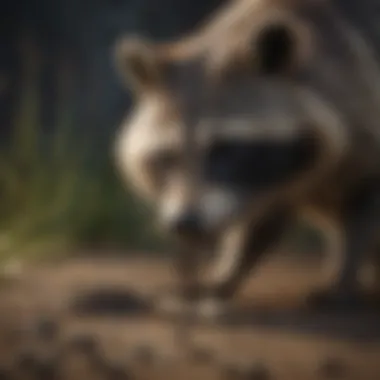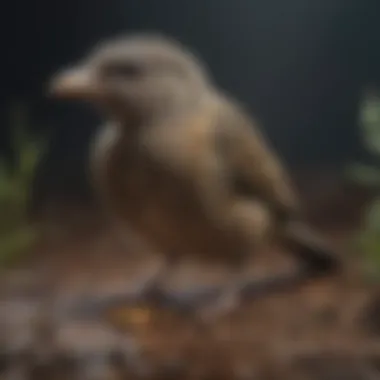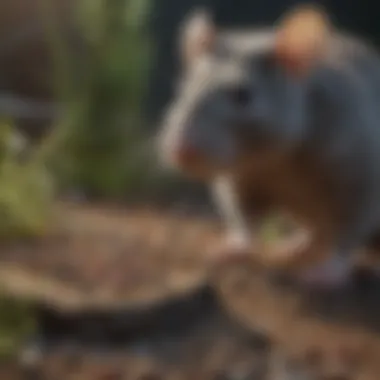Unveiling the Ecological Impact of Rat Poison Pellets on Wildlife


Animal Species Profile
Rat poison pellets, ubiquitous in urban and rural landscapes, have a far-reaching impact on wildlife ecosystems. Their deployment, intended for pest control, inadvertently jeopardizes various animal species through secondary poisoning. One such at-risk species is the barn owl, a nocturnal raptor known for its silent flight and exceptional hunting skills. With heart-shaped faces and mottled plumage, barn owls blend seamlessly into their natural habitats, favoring open grasslands and farmlands for hunting rodents. Their solitary nature is punctuated by monogamous mating pairs, establishing nested territories in old barns or tree hollows.
Introduction to Rat Poison Pellets
Rat poison pellets are a critical component within the realm of pest control, particularly in addressing rodent infestations that pose risks to human health and property. Understanding the composition of these pellets is essential for comprehending their efficacy and potential ecological impacts. The discussion will delve into the intricate details of the chemical ingredients comprising these pellets and their toxicity levels, shedding light on the rationale behind their formulation and usage.
Understanding the Composition
Chemical Ingredients
When examining the chemical ingredients found in rat poison pellets, one can discern a pattern of potent compounds designed to eradicate rodent populations swiftly. The integration of these ingredients is meticulously calibrated to ensure a lethal impact on target pests while striving to minimize non-target exposure. The choices of chemicals are influenced by factors such as efficacy, safety, and environmental persistence, optimizing the overall effectiveness of these pellets in pest control initiatives.
Toxicity Levels
The toxicity levels associated with rat poison pellets are a crucial aspect to evaluate, considering the potential implications across ecosystems. The varying degrees of toxicity determine the lethal dose required to effectively eliminate rats while mitigating risks to other wildlife species. Understanding and managing these toxicity levels are paramount in mitigating unintended consequences within the food chain and broader environment.
Common Brand Names
Comparison of Brands
Within the market, different brands of rat poison pellets vie for attention, each offering distinct advantages concerning toxicity, efficacy, and environmental impact. Comparing these brands involves assessing factors like active ingredients, application protocols, and safety profiles to determine the most suitable option for specific pest control scenarios. By scrutinizing these differences, individuals can make informed decisions aligning with their pest management requirements.
Availability in Markets
The availability of rat poison pellets in markets plays a pivotal role in influencing consumer choices and pest control strategies. The accessibility of these products impacts their utilization in diverse settings, ranging from residential areas to industrial facilities. Evaluating the availability enables stakeholders to gauge the prevalence of these pellets within the pest control landscape, facilitating informed discussions on usage trends and potential regulatory interventions.
Intended Use
Rat Control Methods
Rat control methods incorporating poison pellets offer an expedient solution for addressing rodent populations while minimizing human-wildlife conflicts. The targeted application of these pellets within rodent habitats maximizes their efficiency in curbing infestations, safeguarding public health and integrity of properties. Understanding the nuances of rat control methods enhances the precision and impact of pest management initiatives.
Application Techniques
Effective application techniques are vital for ensuring the optimized dispersion and utilization of rat poison pellets. Proper application methods involve strategic placement, dosage calculations, and compliance with safety protocols to mitigate risks of environmental contamination and unintended wildlife exposures. Proficiency in these techniques is imperative for achieving desired outcomes in rat population reduction efforts.


Impact on Wildlife Ecosystems
In this article, we delve into the critical concept of the impact of rat poison pellets on wildlife ecosystems. Understanding the repercussions of using these toxic substances is paramount in safeguarding the delicate balance of ecosystems. Wildlife ecosystems play a vital role in maintaining biodiversity, controlling populations of various species, and ensuring the ecological balance. Therefore, any disruption caused by rat poison pellets can have far-reaching consequences, leading to a cascade effect impacting not only wildlife but also vegetation and overall ecosystem health.
Secondary Poisoning
Chain Reaction Effects
Secondary poisoning, specifically in terms of chain reaction effects, is a pivotal aspect to consider within the context of wildlife ecosystems. The chain reaction effects refer to the sequential events triggered by the initial exposure of wildlife to rat poison pellets. As predators consume poisoned prey, the toxic substances accumulate, resulting in widespread harm across different trophic levels. This phenomenon highlights the interconnectedness of species within ecosystems and emphasizes the indirect impact of human activities on wildlife populations. While chain reaction effects can help control pest populations, the indiscriminate nature of secondary poisoning poses a significant risk to non-target species and undermines ecosystem stability.
Predator-Prey Dynamics
Exploring the predator-prey dynamics concerning rat poison pellets provides insight into the complex interactions within ecosystems. Predators are vital in regulating prey populations and maintaining ecological balance. However, the introduction of rat poison pellets disrupts this delicate balance by affecting the health and behavior of predator species. This disruption can lead to cascading effects throughout the food chain, altering population dynamics and community structure. Understanding predator-prey dynamics in the context of rat poison pellet exposure is crucial for mitigating the negative impact on wildlife ecosystems.
Environmental Contamination
Soil Pollution
Soil pollution resulting from rat poison pellets poses a significant threat to ecosystem health. The accumulation of toxic elements in the soil can persist for extended periods, affecting plant growth, soil quality, and overall biodiversity. Soil pollution not only impacts terrestrial organisms but also has the potential to leach into water bodies, exacerbating the contamination levels and posing risks to aquatic ecosystems. Mitigating soil pollution caused by rat poison pellets requires comprehensive strategies that focus on remediation and prevention to safeguard ecosystem integrity.
Water Contamination
Water contamination attributed to rat poison pellets represents a pressing environmental concern. The leaching of toxic compounds from contaminated soils into water sources can have devastating effects on aquatic organisms and ecosystems. Increased levels of toxicity in water bodies can disrupt ecological processes, jeopardize water quality, and threaten the overall health of aquatic habitats. Implementing measures to prevent water contamination due to rat poison pellets is essential for preserving aquatic biodiversity and ensuring the sustainability of freshwater ecosystems.
Indirect Effects on Non-Target Species
Birds of Prey
The indirect effects of rat poison pellets on non-target species, such as birds of prey, underscore the complex interactions within ecosystems. Birds of prey play a crucial role in controlling rodent populations and maintaining ecological balance. However, the ingestion of poisoned prey can lead to significant health issues and mortality among these predatory birds. The unique foraging behaviors of birds of prey make them particularly vulnerable to secondary poisoning, highlighting the need for targeted conservation efforts and mitigation strategies to protect these essential species.
Small Mammals
The impact of rat poison pellets on small mammals reveals the intricate web of interactions within wildlife ecosystems. Small mammals serve as key prey species for various predators, contributing to the overall biodiversity and trophic dynamics. Exposure to rat poison pellets can result in population declines, decreased reproductive success, and genetic implications for small mammal communities. Understanding the indirect effects on small mammals is crucial for evaluating the broader consequences of rat poison pellet use and implementing conservation measures to preserve ecosystem resilience and functionality.
Human Health Concerns
In this detailed article discussing the impact of rat poison pellets on wildlife, it is imperative to address human health concerns. The use of rat poison can pose significant risks to human health, especially in cases of accidental exposure. Understanding the potential dangers associated with rat poison exposure is crucial for both public awareness and prevention efforts. By examining human health concerns in relation to rat poison pellets, we can unravel the intricate web of interactions between toxic substances and human well-being. This section aims to shed light on the underlying threats to human health posed by the use of rat poison in various environments.


Risk of Accidental Exposure
Accidental exposure to rat poison can have grave consequences for human health and safety. When individuals come into contact with these toxic substances unintentionally, they may experience a range of symptoms that indicate poisoning. Recognizing the signs of rat poison exposure is vital for prompt medical intervention and treatment. By exploring the risk of accidental exposure in detail, we can grasp the full extent of the potential harm caused by rat poison pellets.
Symptoms of Poisoning
Symptoms of rat poison poisoning may vary depending on the type of toxin present in the pellets. Common signs include nausea, vomiting, dizziness, and weakness. These symptoms can gradually escalate to more severe health issues if left untreated. Understanding the distinct characteristics of poisoning symptoms enables healthcare professionals to diagnose and address exposures effectively. By highlighting the nuances of these symptoms, we enhance our understanding of the intricate relationship between rat poison and human health.
Handling Precautions
Implementing proper handling precautions when dealing with rat poison is essential to minimize the risk of exposure. Adequate protective measures, such as wearing gloves and masks, can significantly reduce the likelihood of accidental poisoning. By emphasizing the importance of handling precautions, we underscore the significance of proactive safety measures in preventing harm. Exploring the unique features of handling precautions illuminates the practical steps individuals can take to safeguard their health in environments where rat poison is present.
Food Chain Contamination
Food chain contamination stemming from the use of rat poison presents a critical concern for human health. Residues of these toxic substances can enter the food chain, potentially leading to long-term health impacts for consumers. Examining the dynamics of food chain contamination provides insights into how rat poison exposure can transcend environmental boundaries and affect human populations.
Residue in Food Sources
The presence of rat poison residues in food sources raises alarming implications for public health. Consuming contaminated food exposes individuals to harmful toxins that can accumulate in the body over time. Assessing the key characteristics of residue in food sources elucidates the pathways through which human populations may be inadvertently exposed to rat poison. By dissecting this aspect of food chain contamination, we deepen our understanding of the far-reaching consequences of environmental toxin exposure.
Long-Term Health Impacts
The long-term health impacts of food chain contamination with rat poison residues are a pressing issue that demands attention. Chronic exposure to low levels of toxins can manifest as various health conditions over time, affecting individuals' well-being. Exploring the intricacies of these long-term health impacts sheds light on the potential risks associated with continuous exposure to rat poison through food sources. By examining this facet in detail, we underscore the importance of mitigating food chain contamination for the protection of human health.
Regulatory Measures
Enforcing stringent regulatory measures is essential for safeguarding human health in the context of rat poison usage. Government policies play a pivotal role in overseeing the production, distribution, and use of rat poison products. By examining the existing regulatory landscape, we can assess the effectiveness of current policies in addressing human health concerns associated with rat poison exposure.
Government Policies
Government policies governing the use of rat poison aim to uphold safety standards and protect public health. Regulations on toxin concentrations, product labeling, and storage requirements help minimize the risks posed by rat poison exposure to humans. Analyzing the key characteristics of government policies sheds light on the mechanisms employed to mitigate human health risks associated with rat poison pellets. By delving into this aspect, we deepen our understanding of the legislative framework governing rat poison usage and its implications for human well-being.
Alternative Solutions
Exploring alternative solutions to rat poison is integral to reducing human health risks while addressing rodent control needs. Implementing environmentally-friendly pest control methods and innovative technologies can offer safer alternatives to traditional rat poison products. By investigating the efficacy of alternative solutions, we unveil a path towards mitigating human health concerns related to rat poison exposure. Assessing the unique features of these alternatives allows us to make informed decisions that prioritize both human well-being and wildlife conservation efforts.
Mitigation Strategies


Rat poison pellets pose a significant threat to wildlife ecosystems, necessitating robust mitigation strategies in this insightful article. The importance of mitigating the impact of these toxic substances is paramount, considering the far-reaching consequences they can have on various species within ecosystems. By exploring mitigation strategies, we aim to highlight proactive approaches to minimize harm and preserve wildlife habitats for future generations. Factors such as efficacy, sustainability, and ethical considerations play a crucial role in designing effective mitigation strategies. This section will delve into the diverse range of approaches that can be implemented to address the challenges posed by rat poison pellets effectively.
Safer Alternatives to Rat Poison
Natural Pest Control Methods
Natural pest control methods offer a sustainable and eco-friendly alternative to traditional rat poisons. These methods leverage the natural behavior of predators or biological controls to manage rodent populations without resorting to harmful chemicals. The key characteristic of natural pest control methods lies in their ability to target pests selectively while minimizing harm to non-target species. This targeted approach not only reduces environmental contamination but also promotes a balanced ecosystem. However, challenges such as longer implementation timelines and variable efficacy rates underline the importance of proper implementation and monitoring.
Humane Rodent Management
Humane rodent management focuses on addressing rodent infestations through non-lethal means, emphasizing the well-being of both rodents and surrounding wildlife. The key characteristic of this approach lies in its sustainable and ethical treatment of pest animals, prioritizing humane practices over lethal control methods. By utilizing live traps, exclusion techniques, and habitat modifications, humane rodent management minimizes animal suffering and promotes coexistence between humans and wildlife. Despite its compassionate nature, humane rodent management may require greater time and effort compared to conventional pest control methods, highlighting the need for patience and persistence.
Community Initiatives
Awareness Campaigns
Awareness campaigns play a vital role in educating communities about the dangers of rat poison pellets and promoting sustainable pest control practices. The key characteristic of awareness campaigns is their ability to inform the public about the ecological impact of rat poison and encourage informed decision-making regarding pest management. By raising awareness about alternative pest control methods and the importance of wildlife conservation, these campaigns empower individuals to make environmentally conscious choices. However, the success of awareness campaigns hinges on effective communication strategies and long-term community engagement.
Local Regulations
Local regulations serve as essential tools in controlling the use and distribution of rat poison pellets, safeguarding wildlife from unnecessary harm. The key characteristic of local regulations lies in their ability to enforce restrictions on toxic substances, ensuring compliance with safe pest control practices. By implementing regulations that govern the sale, storage, and application of rat poison, local authorities can reduce environmental contamination and protect ecosystems. However, challenges such as enforcement gaps and limited resources underscore the need for robust regulatory frameworks and public cooperation.
Collaborative Efforts
Cross-Sector Partnerships
Cross-sector partnerships foster collaboration between government agencies, non-profit organizations, and private entities to address the complex issue of wildlife conservation and pest management. The key characteristic of cross-sector partnerships is their interdisciplinary approach, pooling resources and expertise from diverse fields to achieve common conservation goals. By sharing knowledge, coordinating initiatives, and leveraging collective strengths, these partnerships enhance the effectiveness of mitigation strategies and promote sustainable practices. However, maintaining communication channels and resolving conflicting interests are essential for ensuring the long-term success of collaborative efforts.
Research and Development
Research and development initiatives play a crucial role in advancing innovative solutions for wildlife-friendly pest management. The key characteristic of research and development is its focus on exploring new technologies, practices, and biological controls to mitigate the impact of rat poison pellets. By investing in research projects, testing alternative pest control methods, and evaluating their ecological implications, stakeholders can drive informed decision-making and evidence-based policy development. However, challenges such as funding constraints and regulatory barriers highlight the need for sustained investment and scientific collaboration in this critical field.
Conclusion
In this culminating section of the article, we reflect on the pivotal aspects underscoring the profound impact of rat poison pellets on wildlife ecosystems. The in-depth exploration of secondary poisoning, environmental contamination, and indirect effects on non-target species has laid bare the intricate web of consequences stemming from the use of these toxic substances. By unraveling the interconnectedness of these issues, we have illuminated the urgent need for mitigation strategies to safeguard our delicate ecosystems.
Call to Action
Protecting Wildlife Habitats
Delving into the realm of protecting wildlife habitats, we encounter a crucial facet of conservation efforts that resonates deeply within the narrative of this discourse. The preservation of these habitats serves as a linchpin in the overarching goal of restoring ecological balance and securing the future of diverse wildlife populations. The intrinsic value of safeguarding these natural territories lies in the profound impact it holds not just for the present but for generations to come.
Advocating for environmentally safe practices emerges as an ethical imperative in confronting the looming threats posed by rampant pesticide use. By championing the adoption of sustainable, ecologically friendly alternatives, we pave the way for a paradigm shift toward harmonious coexistence with nature and its inhabitants. The enduring relevance of this advocacy lies in its capacity to effect tangible change on both individual and collective levels, creating a ripple effect of positive outcomes for our ecosystems and future generations.







